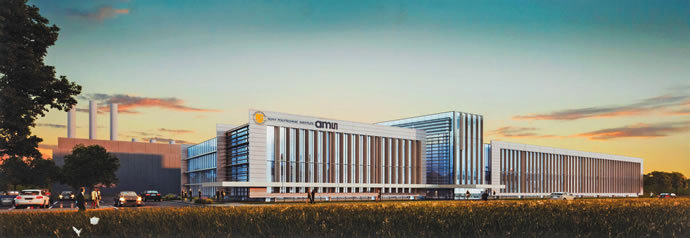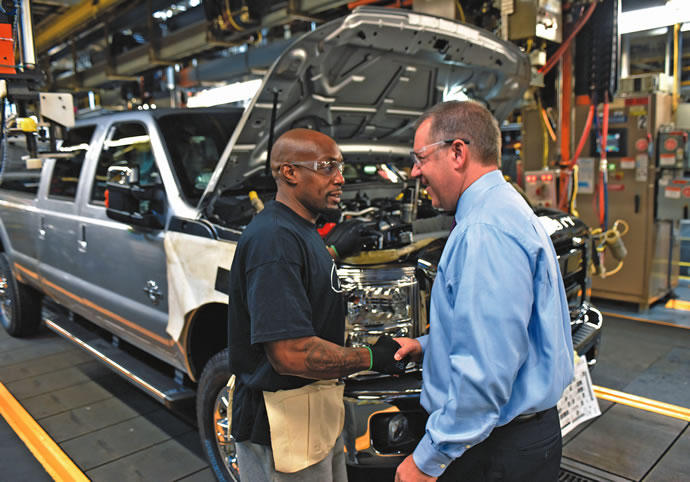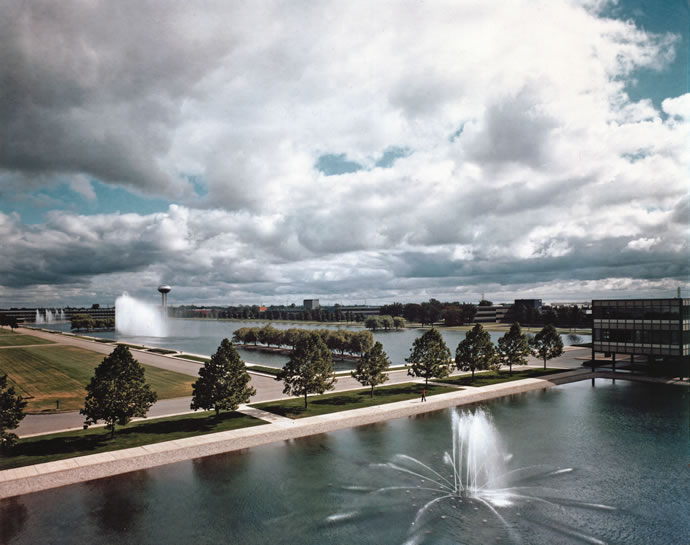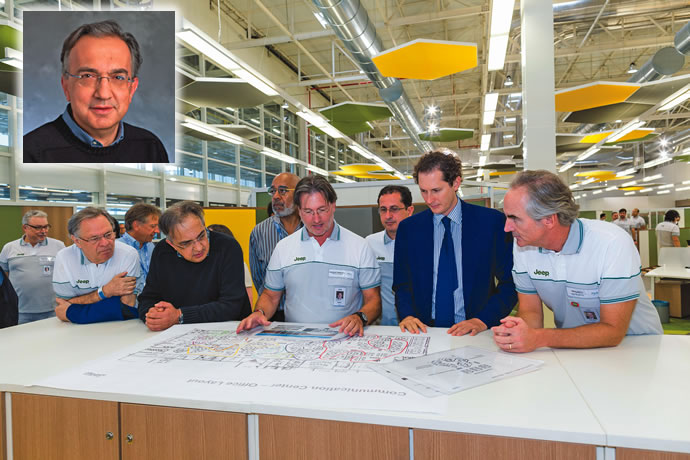What gets a megaproject across the finish line? What blend of circumstance, strategy, timing and relationships inspires companies to cement commitments worth billions of dollars and sometimes thousands of jobs?
Study Site Selection’s Top Deals of the Year and you’ll come away with some answers. Using an initial formula based on projects’ combined capital investment and job creation totals, we also examined such factors as competition for the project, regional economic impact (including per-capita analysis) and obstacles/challenges overcome.
However you sort the reasons, the Top Deals all amount to one thing: opportunities for growth — in innovation, market share, regional GDP and, in many cases, human as well as profit potential.
TOP NORTH AMERICAN DEALS
American Specialty Alloys, Pineville, Louisiana
Mississippi-based American Specialty Alloys Inc. (which changed its name to Revolution Aluminum LLC in Oct. 2015) in February 2015 announced plans to develop an aluminum mill at the 1,200-acre (485-hectare) former International Paper containerboard manufacturing site (closed in 2010) in Pineville, part of the Alexandria metro area. Plans call for an eventual 3,000-acre (278-hectare) campus. ASA picked the property over competing sites in Tennessee, Alabama and Mississippi.
“We studied many factors essential to the project success, including property characteristics, community engagement, workforce readiness and the quality and support of local service providers,” said ASA CEO Roger Boggs, crediting strong coordination between state and local entities.
Central Louisiana Economic Development Alliance President and CEO Jim Clinton credited the efforts of the state, utility Cleco Corporation’s economic development team and the Red River Waterway Commission, which supported the creation of a new port to serve the facility.
AMS AG, Marcy, New York
In August, AMS — a maker of advanced sensor technologies and analog integrated circuits with operations in more than 20 countries — announced it planned to help create more than 1,000 new jobs overall and invest over $2 billion over 20 years to support a wafer fab at the Nano Utica site in Marcy. Beginning in spring 2016, AMS will construct, staff and operate the facility in partnership with New York State, SUNY Polytechnic Institute’s Colleges of Nanoscale Science and Engineering (CNSE), Fort Schuyler Management (FSMC) and Mohawk Valley Edge.

Gov. Andrew Cuomo’s Nano Utica initiative — designed to replicate SUNY Poly’s successful Nanotech Megaplex in Albany — now exceeds 4,000 projected jobs over the next 10 years. “Our decision to locate the facility in New York was motivated by the highly-skilled workforce, the proximity to esteemed education and research institutions, and the favorable business environment provided by Governor Cuomo and all the public and private partners we are working with on this important project,” said AMS COO Dr. Thomas Stockmeier.
Faraday Future, North Las Vegas, Nevada
Of the eight Top Deals globally from the automotive sector (plus four honorable mentions), this Chinese-backed venture establishing a North American electric vehicle manufacturing beachhead is arguably the most visionary, landing at Apex Industrial Park. The Nevada team was visionary in its own right, presenting legislation to create a new incentive tier, coordinating approval for infrastructure bond funding and developing a new workforce training program for the project.
Cushman & Wakefield Strategic Consulting led site selection and incentives negotiations for “Project Robin,” completing the property search, labor market due diligence, financial evaluations and incentive negotiations over a 10-month period. The team worked with Faraday to evaluate over 100 properties, both brownfield and greenfield, in 10 US states and portions of Mexico, weighing human resources costs and labor availability, access to supplier and customer markets, real estate and infrastructure suitability and incentives.
Ford Motor Co., Louisville, Kentucky
It’s yet another major expansion in Louisville for Ford, which since 2004 has invested six times in the city, where it first launched production in 1913 to make Model Ts. The Kentucky Truck Plant, where this investment is occurring, opened in 1969, covers 6 million sq. ft. (557,400 sq. m.) and employs close to 4,400 people. It has produced more than 5 million Ford F-Series Super Duty trucks since the model series was introduced in 1999, and will support the launch of the 2017 Ford F-Series Super Duty truck with an all-new body shop, facility upgrades and retooling.

Ford has invested more than $1.5 billion in Kentucky and the city of Louisville in the past two years. Ford’s separate Louisville Assembly Plant, opened in 1955, employs nearly 4,800 people across three shifts producing the Ford Escape as well as the Lincoln MKC.
Ford Motor Co., Irapuato, Guanajuato, Mexico
This project was one of a pair announced in April, as Ford celebrated its 90th year in the country by joining Mexican President Enrique Peña Nieto to announce a total $2.5-billion investment in two new facilities in Chihuahua (engines) and Guanajuato (transmissions) that together will create 3,800 new jobs.
The new transmission plant breaks new ground in a couple of ways. It’s Ford’s first transmission facility in Mexico, and it will be located within the premises of transmission supplier and longtime Ford partner Getrag, which is based in Irapuato. Ford has 11,300 employees in Mexico, including 1,100 at its Engineering Center.
General Motors, Warren, Michigan
In May, GM announced it would create these new salaried jobs in core areas like product engineering, IT and design at GM’s Warren Technical Center, recently declared a National Historic Landmark. The center, designed by world-renowned architect Eero Saarinen and landscape architect Thomas Church, opened in 1956, and is currently home to more than 19,000 employees. “This is an investment in our people, our products, and, ultimately, our customers, to make the Tech Center a more advanced, more efficient and more collaborative workplace,” said Mark Reuss, GM executive vice president, Global Product Development and Purchasing and Supply Chain.

In addition, GM previously announced $139.5 million for body shop and stamping facility upgrades at its Warren Pre-Production Operations, part of a $5.4-billion investment in US plants announced in April 2015. Warren Mayor Jim Fouts said the investment “has already resulted in proposals for new investments in our downtown, which is directly across the street from the Tech Center.”
Grupo Bafar, Michoacán, Mexico
This Mexican conglomerate in July 2015 announced it would construct a major agro-industrial complex and cogeneration power plant in La Piedad, Michoacán. Grupo Bafar CEO and President Eugenio Baeza said geography was part of the picture, in order to access quality meat sources and to reach customers with the company’s many food brands. The site also is positioned on rail lines operated by Ferromex and by Kansas City Southern de Mexico. But the investment is also about committing to a comeback for a region torn apart by violence.
“Our decision to establish a new center of operations in Michoacán is due to the valiant efforts by the federal and state governments to overcome the crisis of violence in the state and reestablish, little by little, order and the rule of law,” said Baeza, according to Mexico News Daily.
LEGO, Cienega de Flores, Monterrey, Mexico
This project is one of a family of investments the Danish firm announced in October 2015, in addition to factory expansions in Hungary and Denmark. LEGO plans to add up to 190,000 sq. m. (2 million sq. ft.) to its 3,500-employee, 150,000-sq.-m. (1.6-million-sq.-ft.) Monterrey facility, including additional moulding, processing, packing and warehousing space.
“The exact details of the expansion and investment will naturally depend on the future development in demand for LEGO products,” said Bali Padda, COO and executive vice president.
“Based on our current expectations we project an additional 3,000 colleagues in the factory in Mexico by 2022.”
Toyota Motor Corp., Celaya, Guanajuato, Mexico
Like Ford, Toyota liked what it was seeing in Guanajuato enough to build a billion-dollar plant. The facility will be Toyota’s 15th in North America, its first since 2011 and its largest investment in Mexico to date. It will begin producing the Corolla with model year 2020, with a capacity to churn out 200,000 units annually.
The project is part of a multi-year realignment of Toyota’s manufacturing operations in North America in support of the Toyota New Global Architecture. The plant will leverage the existing robust supply base and transportation infrastructure in the region. Toyota will also establish a plant preparation office in the state of Queretaro. “Having produced vehicles in this country for more than 13 years, we know that the strength of the workforce and manufacturing capabilities in advanced technology make Central Mexico the right place for our newest facility,” said Mike Bafan, President, Toyota Motor Manufacturing de Baja California, Inc. (TMMBC) and project leader for the new plant.
Volvo, Ridgeville, South Carolina
Volvo Cars in May chose Berkeley County, outside Charleston, for its first North American factory, where it plans to initially produce up to 100,000 cars per year for domestic sales and export when the first vehicles roll out in 2018.
“We’re excited to build our first American factory in South Carolina and we look forward to helping grow the local community and economy,” said Lex Kerssemakers, president and CEO of Volvo Cars of North America, of the Swedish company’s long-awaited foray onto American soil — the company began importing to the US in 1955. “We were impressed with the friendliness, work ethic and passion of the people in the Charleston area.”
An economic impact analysis compiled by Dr. Frank Hefner at the College of Charleston estimates that, for an initial 2,000 direct jobs, more than 8,000 total jobs would be created as a result.
NORTH AMERICA HONORABLE MENTIONS
1366 Technologies, Alabama, New York
Advanced Munitions, Alcoa, Tennessee
Apple, Mesa, Ariz.
Ford Motor Co., Chihuahua, Mexico
FreshDirect, New York, New York
General Motors, Arlington, Texas
Liberty Mutual, Plano, Texas
Mercedes-Benz Vans/Daimler, North Charleston, South Carolina
Novo Nordisk, Clayton, North Carolina
Procter & Gamble, Martinsburg, West Virginia
TOP INTERNATIONAL DEALS
Energy Recovery Systems, Antwerp, Belgium
Saudi Arabia’s Energy Recovery Systems proposal was selected by the Antwerp Port Authority for developing the southern and northern areas of the port’s Delwaide dock with the construction of a new production unit for green ammonia and green urea. Called a Waste to Chemicals project, the factory will receive non-recyclable industrial waste by ship, with gasification used to convert the materials to synthetic gas and ultimately ammonia and urea. “Ammonia is a raw material used in the chemical industry and is much demanded by the Antwerp chemicals cluster,” said the port authority, while global demand for urea is increasing. “Located in the middle of a chemicals cluster, easy accessibility for ships along with a good rail and road infrastructure, a wide network of pipelines for distribution, a highly trained workforce, high quality contractors … these were all reasons for choosing Antwerp,” said the port of the project, which will be operational by 2020.
“We may all be proud that a world’s first in the field of green ammonia and green urea will be arriving in Antwerp, so the sustainability of the Antwerp chemical cluster is assured,” said Albert Van Rillaer, CEO of ERS.
Fiat Chrysler, Goiana, Pernambuco, Brazil
In my decades of international experience, the revolution here in Pernambuco is the most profound I have ever seen,” said Sergio Marchionne, CEO of Fiat Chrysler Automobiles, last April of the company’s massive next-generation Jeep production complex in Pernambuco, an area formerly given over to mostly sugar cane production.
Over two years in development, the project was inaugurated in April 2015 with a total site investment of $2.5 billion. “Pernambuco is FCA’s first truly global plant, planned and executed from the ground up by an intercultural team and the first to incorporate, from day one, best practices developed at Group sites around the world,” said the company. Among its assets are 700 robots and an on-site supplier park with 16 suppliers and 12 different factories. It was expected that more than 9,000 people would be working at the site by 2016.

“Today we are not just celebrating the opening of an industrial complex, or a brand or product,” said Marchionne. “We are celebrating the spirit of Pernambuco and its people. Without them this extraordinary and ambitious project would not have been possible.”
Foxconn, Maharashtra, India
The Taiwanese electronics giant, best known for its iPhone supply arrangement with Apple, in August signed an agreement to invest $5 billion over five years in a new semiconductor manufacturing facility in Maharashtra, just one week after GM committed to investing $1 billion there. According to the Times of India, the company was offered a 1,500-acre (607-hectare) site in the MIDC estate at Talegaon, near Pune, not far from the proposed site of the Navi Mumbai international airport.
According to the report, Foxconn Chairman Terry Gou credited “state leadership and progressive response from the government for choosing Maharashtra over other states.” Then the account included this statement … not unbelievable to those who have seen its Chinese complexes: “Foxconn plans to create over [1] million jobs in India by 2020.” According to the report, Foxconn is talking to other Indian states about other plants, and may invest up to $20 billion in India alone, potentially in partnership on some projects with multinational conglomerate Adani Group.
Helm AG, Mtwara, Tanzania
With the completion of a major gas pipeline in September, plans for a major petrochemical complex from Germany’s Helm continued to move forward at a 430-hectare (1,063-acre) within the Mtwara Special Economic Zone adjacent to Mtwara Port.
With revenues over $10 billion and nearly 1,500 employees at operations in more than 30 countries, Helm is already global, but until now Africa has represented only 1 percent of its market.
Part of the investment will go toward a fertilizer plant expected to manufacture more than 1 million metric tons of urea annually, with half of that to be exported. Some of the remainder will go toward the country’s major food producing regions nearby.
Infineon Technologies AG, Wuxi, Jiangsu Cheng, China
On the occasion of its 20th anniversary of operation in China, Infineon in October announced it would build a second factory in Wuxi. The new 36,000-sq.-m. (387,515-sq.-ft.) factory is scheduled for rollout at the end of 2016. Dr. Reinhard Ploss, CEO of Infineon Technologies AG, said the project “highlights Infineon’s confidence in the continuous opportunities of the Chinese market as well as our commitment to substantial investment in China and our determination to support the ‘In China, For China’ strategy.”
The semiconductor company’s factories in China already supply products across a wide range of industry sectors, including Internet of Things (IoT) applications. “Since the rollout of the ‘Made in China 2025’ strategy, Infineon has been strongly supporting China’s ambition to become a leading manufacturing power, through in-depth cooperation with local partners and by virtue of its leading semiconductor technologies,” said the company. “Recognized as the ‘IoT pilot city of China,’ Wuxi has unique advantages in IoT-related research and applications. Infineon has established and is maintaining a long-term partnership with the Wuxi-based Internet of Things Research and Development Center of the Chinese Academy of Sciences, and provides one of the 10 IoT reference cases in the city with its IoT-enabled facility. The new factory in Wuxi will leverage Infineon’s proven expertise in sensing, security, power and micro-control, thus enhancing the connection between IoT and manufacturing — a forceful driver of the industry’s smart transformation.”
Jaguar, Solihull, United Kingdom
Jaguar Land Rover announced plans to create 1,300 new jobs as it “continues to accelerate its industry-leading expertise in aluminum and lightweight technologies.”

“Today’s announcements once again demonstrate our commitment to the UK and the advancement of a high-tech, high skilled, manufacturing-led economy,” said Jaguar Land Rover CEO Dr. Ralf Speth. Even as the company has invested in new plants in Changsha, China, and in Brazil, its commitment to its home country remains steadfast. The company’s headcount has increased to 32,000 —30,500 in the UK, and 10,000 more than were employed just four years ago. The company plans 50 product actions over the next five years, of which 12 were scheduled for 2015 alone.
To support the introduction of its new aluminum and lightweight technologies, Jaguar Land Rover has already invested £1.5 billion (US$ billion). The new “factory with a factory” facilities represent the largest single investment in the Solihull plant in its 70-year history, incorporating Europe’s largest aluminum body shop and final assembly hall.
Maxxis/Cheng Shin Tire, Sanand, Gujarat, India
Maxxis employs 30,000 worldwide, making tires for everything from racecars to mountain bikes to trailers. Scheduled to be operating in early 2017 from a 106-acre site at the Sanand Industrial Estate near Ahmedabad, the new plant from Maxxis (also known as Cheng Shin Tire) will initially make motorcycle tires and tubes at the rate of 20,000 daily.
The Gujarat plant will join 10 other Maxxis plants located throughout Asia.
“Maxxis looks forward to the completion of this project, and thanks Chief Minister Anandiben Patel and everyone involved for their efforts in bringing the company’s new factory to Gujarat,” said the company in October.
POSCO/Shree Uttam Steel and Power, Satarda, Maharashtra, India
Shree Uttam Steel & Power Limited, part of a larger company called Uttam Galva, in August signed a JV agreement with POSCO to set up a steel plant with annual production of 1.5 million tons at Satarda village in Maharashtra, just north of the Terekhol River and a day’s drive south of Uttam Galva’s main manufacturing facilities at Khopoli, close to the Nhava Sheva and Mumbai ports. “The JV will allow Uttam Galva to develop an integrated steel manufacturing facility in line with the Indian Government’s ‘Make in India’ initiative,” said a Bloomberg report.
Uttam Galva Steels is one of the largest manufacturers of cold rolled steel (“CR”) and galvanized steel (GP) in Western India, with more than 50 percent of its products exported to 132 countries. At home, the company has established itself as a major supplier of Cold Rolled Closed Annealed (CRCA) coils. The company is also a large supplier of galvanized coils and sheets to the construction industry.
As for Posco, the project will mean welcome progress in a country that has not provided much of that up to now. The company initially pledged to build a steel plant in Orissa in 2005, but was met with problems that ranged from environmental clearances and land procurement challenges to constant protests and even the 2007 kidnapping of three executives. Citing restructuring, it postponed that $12-billion project in July 2015, two years after scrapping plans for another Indian plant in Karnataka.
Wuhan China Star Optoelectronics Technology Co., Wuhan, Hubei Sheng, China
Expected to launch mass production by 2017, this production line will churn out 88 million LCD display panels or modules annually, helping the entire complex reach a total of more than 10 billion units annually.
The plant, located in the Wuhan East Lake High-tech Development Zone, was originally sited in 2014 with an investment of more than $2.4 billion from Shenzhen China Star Optoelectronics Technology Co Ltd (CSOT), a subsidiary of Huizhou, Guangdong-based electronics giant TCL Corporation, ranked 55th on the latest Fortune China 500 list. As reported early this year in China Daily, Wuhan area leaders continue to try to attract further investment in this niche, in order to challenge the longstanding leadership of companies in South Korea and Japan. Their area is dubbed “Optical Valley.”
Workforce development is one way TCL is helping. Of the 1,385 new employees welcomed in a “graduation” and induction ceremony last July, 30 percent had master’s degrees. They’re trained well too: In a June 2015 release celebrating the capping of the plant 16 days ahead of schedule, the company stated, “From the start to the capping of the main plant, more than 400,000 square meters [4.3 million sq. ft.] [of] plant and supporting facilities have been completed within only 286 days, revealing the advantages of CSOT’s efficiency and speed.”
ZTE Corp., Changsha, Hunan Sheng, China
TCL’s fellow high-tech multinational ZTE is building its “ZTE Changsha Base Project” in Changsha Development Zone for Hi-tech Industries, one of the first 27 national-grade hi-tech zones approved by the State Council in 1991.
“As one of the only seven exemplary zones for proprietary innovation in China and the only core industries zone of national-grade hi-tech zones in Central China, Changsha Hi-tech Zone leverages vigorously on its double strengths and opportunities presented by the ‘Made in China 2025’ initiative to build itself into a base for high-end manufacturing, R&D and conversion with a special focus on the electronic information sector as a pillar industry for the zone,” noted ZTE in filed documents. “In this connection, it has also been designated as a ‘Hub for the Mobile Internet Industry of Hunan Province’ and a ‘Mobile Internet Feature Industry Park of Hunan Province.’ “
ZTE acquired land use rights for 50 years. The 260,000-sq.-m. (2.8-million-sq.-ft.) plant will feature R&D and production for set-top box and other smart equipment, Internet products and storage products, and software relating to wireline communications and cloud terminals. ZTE invests more than 10 percent of annual revenue in R&D, operates 20 R&D centers worldwide, employs over 30,000 researchers, and has ranked in the top three worldwide in patent filings since 2010.
INTERNATIONAL HONORABLE MENTIONS
Biogen Idec, Zurich, Switzerland
Dangote Cement, Mugher, Ethiopia
Exxon Mobil, Bengaluru, India
GSK, Singapore
Huchems, Tanjung Kiduron, Sarawak, Malaysia
Hyosung Corp., Nam-gu, Ulsan, South Korea
Intech/Glo-Tech, Karoli, Rajasthan, India
Nissan Motor Co., Cordoba, Argentina
Rolls-Royce, Singapore
Siemens, Cuxhaven, Germany

